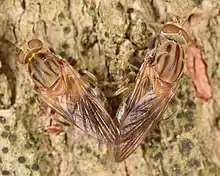Brachyopa vacua
Brachyopa vacua (Osten Sacken, 1875), the Yellow-spotted Sapeater, is a rare, species of syrphid fly. It has been observed in Canada, Alaska and northern United States. Hoverflies get their names from the ability to remain nearly motionless while in flight. The adults are also known as flower flies for they are commonly found around and on flowers from which they get both energy-giving nectar and protein-rich pollen. Larvae for this genus are of the rat-tailed type. B.vacua larvae were collected from the juice of decaying fungi under dead bark.[2][3]
| Brachyopa vacua | |
|---|---|
 | |
| Brachyopa vacua pair | |
| Scientific classification | |
| Domain: | Eukaryota |
| Kingdom: | Animalia |
| Phylum: | Arthropoda |
| Class: | Insecta |
| Order: | Diptera |
| Family: | Syrphidae |
| Subfamily: | Eristalinae |
| Tribe: | Brachyopini |
| Subtribe: | Brachyopina |
| Genus: | Brachyopa |
| Species: | B. vacua |
| Binomial name | |
| Brachyopa vacua Osten Sacken, 1875[1] | |
| Synonyms | |
| |
Description
7 to 10 mm. long Head a dirty yellow with a brown stripe on the cheek. Thorax with yellow hair and a double row of dark median lines. Scutellum with yellow hairs. Large yellow spots on the second abdominal segment. Wings, longer than last abdominal segment. Legs brown with light yellow at joints.[3][4][5]
Larvae and puparium
Larva. Length, 8 mm.x 3 mm., appears opaque yellow-ochre, brown, to black. Pointed anteriorly, widening in middle. Entirely wrinkled and covered with black spines ventrally. Puparium Length7 mm. cylindrical, wedge shaped in profile. The pupal spiracles are reddish-brown, conical, and curved outward, bearing numerous small tubercles around the sides and with one at the apex. The larvae was taken from the juice of decaying fungi under dead bark of a tulip tree.[6]
Distribution
Source:[7]
Utah, Minnesotans, Iowa, Kansans, Missoula, Illinois, Michigan, Pennsylvania, Tennessean, Georgia, Virginia, Maryland, Massachusetts, Connecticut
Ontario, Nunavut, Québec
References
- Osten Sacken, Carl Robert (1875). "A list of the North American Syrphidae". Bulletin of the Buffalo Society of Natural Sciences. 3: 38–71. Retrieved 11 November 2021.
- Heiss, Elizabeth Madeleine (1938). "A classification of the larvae and puparia of the Syrphidae of Illinois exclusive of aquatic forms". Series: Illinois Biological Monographs. 16: 1–142. end of template cite journal
- Skevington, J.H.; Locke, M.M.; Young, A.D.; Moran, K.; Crins, W.J.; Marshall, S.A (2019). Field Guide to the Flower Flies of Northeastern North America. Princeton Field Guides (First ed.). Princeton, New Jersey: Princeton University Press. p. 512. ISBN 978-0-691-18940-6.
- Williston, S.W. (1887). "Synopsis of the North American Syrphidae". Bulletin of the United States National Museum. 31: 1–335.
- Curran, Howard (1922). "The Syrphid Genera Hammerschmidtia and Brachyopa In Canada". Annals of the Entomological Society of America. 15 (3): 239–255. doi:10.1093/aesa/15.3.239.
- Greene, C.T. (1914). "A contribution to the biology of North American Diptera". Proceedings of the Entomological Society of Washington. 19: 146–161.
- "Brachyopa vacua". GBIF. Retrieved 2022-12-05.
External links